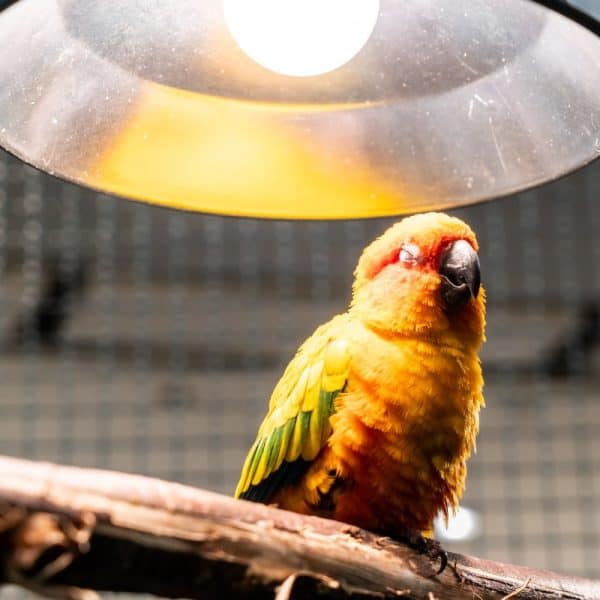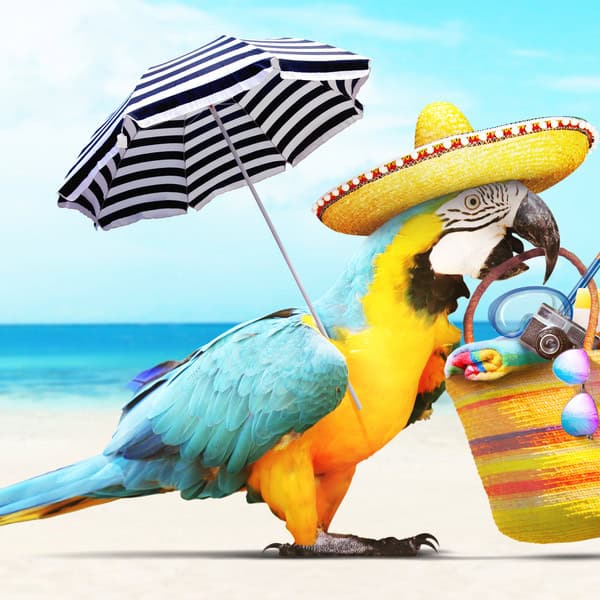Last Updated on by Mitch Rezman
Jan 9, 6:36pm
Hello, I have two Caiques. The first we have had for 6 years and is sweet mostly. The second, we introduced about 2 years ago. At first, the two about killed each other, but now they are friends.
However, the second caique does have an issue with wanting to be super nice to me and then all of the sudden out for blood. It goes for fingers, almost always. I am fairly sure it had a bad childhood and feel awful for it. It has some great times, but then sometimes will revert and attack. It goes in phases.
I am curious if you have any ideas of how to break this? Currently, to hold the bird or get it, most times I need to have a towel, which it is so smart to hold it’s wings out so I cannot wrap it up. It flips out from the towel also so I cannot grab it, always going for fingers and biting. Thank you for any information! Sometimes I’m at my wits end with this bird, but have been trying and trying to make it have a great life.
Greetings Kristie and Raschko
It would be helpful to know the sex of the two birds and their names. If you don’t know I would encourage you to get them both DNA sexed it will help with sorting this thing out.
In that your bird fears the towel this may have a bad implication down the road should you have a medical emergency and need to wrap the bird in a towel to control it.
Have you tried to use a stick (perch) so that you can transport the bird without getting bit? Here’s an example:
https://www.youtube.com/watch?v=wOvXt3IFnp8
I don’t think this is anything to do with the second bird’s bad childhood I think it’s more about, “but now they are friends.”
The second bird has taken the first bird as a mate (or close buddy) and cut you out of the deal. The lunging/biting is to keep you away from the first bird as the second one is very jealous.
Are they housed in the same cage or do they have different cages?
Do you employ any sort of artificial lighting? How much “foraging and enrichment” are they exposed to?
https://www.youtube.com/watch?v=XxTjgpXPkQU
Both birds can benefit from clicker training. In your case, I would advocate using a long millet spray as a reward which would keep your hand 6 inches away from your bird’s beak. Examples of clicker training
Hello and thank you very much for your reply!
We have not had the birds sexed or DNA tested. I know the cost is very low to do the testing. We have been told the first bird we had appears to be a female due to the pelvis, but no one has seen the second one to evaluate it, so we are not sure. The names of the birds, oh yes!
The first bird we had, is named Chicken Noodle. It does have a Facebook page if you search Chicken Noodle Caique Parrot. It’s quite animated and friendly. The second bird we have is named Alfie – this is the one that bites.
I can understand what you mean about the towel being a negative implication. The reason I went to the towel is because we have more than one cage the birds go to and Alfie would bite my fingers when I would move it.
I had to move the birds from one cage to another and so it was the quickest way to do it. Also, neither are clipped and Alfie flies rather well, so it was in an effort to contain it as well. One cage we have is outdoors, so this is important in that regard.
Since I read your email, I did grab an old toothbrush and at first, Alfie didn’t know what to think, but did step on, so I will try a stick. Though, since I emailed you, Alfie has been coming to me willingly, almost wanting to come sometimes? It goes in phases, and this is normal, so I cannot explain what the changes in the biting come from.
There doesn’t appear to be jealousy, from what I can see from bird to bird in the fact they are friends. But maybe I’m missing something. I’m the sole caregiver of them. They get along really well and do not seem to be mated or anything of the sorts, though they do like to be together or nearby or they make honking noises.
Chicken Noodle wants nothing more than to be with me almost all the time, honestly. I will say that Chicken Noodle will be aggressive toward my husband, however, in a similar way that Alfie can be aggressive and want to bite me. So I would say Chicken Noodle would be mated to me more than anything. Ha. Having said that,
Alfie is scared to death of my husband (even after two years and he’s never done anything to make the bird feel this way) and appears to only like females. It WILL chase my son and want to bite him as well. It’s scared of about every male other than being aggressive towards my son. It’s been awhile since it’s done that, though, but it would fly across the room out of nowhere and want to attack him for no reason.
This is similar to how Chicken Noodle acts to my husband now, but puff’s up and will literally fly over to him and want to attack his neck or fingers even when he’s doing nothing but just being across the room.
I have some video’s from this last year. The links are below. Some of them may appear to be that I’m antagonizing Alfie, but in both cases, I was trying to either put the birds in their cage or move them from one cage to another cage. So in a way a bull would want to fight the matador, this is how Alfie can act. I will work on not using a towel and see if using a stick works and then I can hold Alfie then without a bite.
I haven’t always had to use a towel. This started last summer with the finger biting. Sometimes it’s cute and funny, but also scary, because a bite can hurt really bad, obviously and almost always draws blood and causes a bruise! I’ve had several bites and still have some healing on my fingers from the recent past. I do file the points off of beaks because of this. I’m nothing but nice to the birds…!!! 🙂
You can see sometimes Alfie thinks this is really very funny and it’s quite proud of itself for how it’s acting. It hops and laughs, or appears to be happy!! And having fun at my expense. Ha ha. Someone who knows the behavior of Caiques may be able to explain more. Obviously, both birds have some similar behaviors, but then some are different as well. They both LOVE to surf (rub on towels), it’s their favorite thing to do.
I do think they could both use more exercise and Alfie loves to fly from one end of the house to the cage again. This is what I mean, by sometimes it is totally fine, then other times it’s not and wants to bite. Chicken Noodle had to learn how to fly and still doesn’t like to fly at all. I have a flight harness for it, but it’s a cheater and doesn’t fly, ha.
There are variables somewhat in Alfie’s actions, but this type of behavior you see in the videos is probably how it mostly acts when I want to move it from one cage to another and it’s pupils dilate, and it get’s all crazy. Or sometimes it just jumps by the door and wants to bite through the cage if it can and I cannot even get the door open without a distraction.
Sometimes it will be very happy and even regurgitate food, and want to get on my finger, then bite the crap out of me. So, I always feel I have to be cautious, even if it’s being nice. Alfie’s nickname is Dr. Jekyll and Mr. Hyde. Ha.
Anyway, here is a link to a couple of videos. Thank you again!
Kristie
Hi Kristie – my thoughts
Chicken Noodle bonded with you when you originally got him. The three of you (you, CN, and hubby) had probably been getting on swell until the dynamic changed when you brought Alfie into the house. You instantly went from pet companion to zookeeper.
Alfie is now bonded with Chicken Noodle (The only other flock mate with feathers) which is why he attacks you, he prefers you not come into CN’s space. Chicken Noodle attacks your husband because of the early bonding that occurred six years ago so CN does not want him in his space with you.
Aside from clicker training, after watching the videos a larger issue is that your birds have no enrichment or foraging opportunities. The top of the cage except for a bell looks like a jail cell. They don’t even have food cups. Thus all they do is sit up there and obsess about how they love each other and how much they hate all the humans in the household (I speak bird).
Try setting up a couple of foraging stations- start with filling both feeder cups ¼ full with food and then on top of the food add items they need to remove in order to access the food. This can be newspaper balls, vine balls, finger traps or toy parts – anything to slow them down from accessing the food in the bottom of the bowls.
Caiques need a constant stream of stimulation. Lots of foot toys – golfball sized whiffle balls – ketchup cups you can steal from fast food restaurants with little treats – and more stuffing to rip apart. Drinking straws are fun. Steal a bunch from McDonald’s then wrap a cable tie around the center and pull it tight for a “straw blossom“.
They definitely need something to do to take their mind off of the current situation. We feel toys in the bird’s cage are the leaves in the trees that the birds would be spending the night in in the wild. There should be more than enough toys so birds can hide behind them when they go to sleep and have a sense of privacy.
Although the cage is near a large glass door and you do have an outside cage you’re still being subjected to the light cycles of North America (I’m assuming) having an additional full-spectrum light on top of their indoor cage that is on a timer with 12 hours on and 12 hours off will also help keep their circadian clock synchronized with their body and brain.
Using your towel is a game that will eventually come back to haunt you when you going to need the ability to towel your bird in the medical emergency IMO. Also, the birds rubbing on the towels can bring on sexual behavior that you do not want to encourage.
Please let me know how the foraging opportunities work out .
Please share with us any successes you achieve and feel free to reach out anytime.
mitchr
approved by catherine tobsing
your zygodactyl footnote
Author Profile
Latest entries
 The Traveling BirdJune 26, 2025Can You Name 5 Parrot Species That Are Living Wild in the USA?
The Traveling BirdJune 26, 2025Can You Name 5 Parrot Species That Are Living Wild in the USA? Bird BehaviorJune 26, 2025How is it Parrots Are Problem Solvers Social Animals and Even Use Tools?
Bird BehaviorJune 26, 2025How is it Parrots Are Problem Solvers Social Animals and Even Use Tools? Bird & Parrot AnatomyJune 25, 2025How a Tiny Chemical Modification Makes Parrots Nature’s Living Paintings
Bird & Parrot AnatomyJune 25, 2025How a Tiny Chemical Modification Makes Parrots Nature’s Living Paintings PigeonsJune 20, 2025How Do Parrots Thrive in Cities Outside Their Native Habitats?
PigeonsJune 20, 2025How Do Parrots Thrive in Cities Outside Their Native Habitats?





Vickie
29 Jan 2017Hi Kristie,
Very cute caiques! I have three, 2 male White Bellies and 1 female Black Headed. The one WB and the BH are cage buddies.
You asked for comments from Caiques owners on the Windy City site, so I am offering my thoughts. I offer my thoughts with the kindest and humblest of intentions.
From these videos, it looks as though Alfie is limping on his right foot. Could he be in pain sometimes and that is when he turns into Mr. Hyde? Has a vet checked him/her.
Believe me, I know how hard it is not to laugh at caique behavior, but when my caiques are behaving in an aggressive way (as Alfie is doing on the floor), I either walk away (possibly laughing inside myself at the antics) or put the bird quietly in its cage. Because I don’t want to reward bad behavior by responding to it.
I think perhaps Alfie is like the puppy whose owners play rough with him and then doesn’t understand that “rough” play is not always acceptable.
Also you say Alfie is flighted, and caiques can be pretty cocky when flighted.
One other thought. I lost a bird once who unexpectedly flew off (he was found 3 days later, but died from the physical trauma two months later). So, I am paranoid about the risk of parrots outside. Please be very careful that your birds can’t escape from the cage.
You might also want to think about putting the outside cage next to the house. A hawk overhead could see your birds as lunch. Although your birds are in a cage, a hawk could reach in and hurt them very badly or even fatally.
Thank you for reading my comments. You, I think, have two of the most charming breed of parrots one can have. Good luck with them.
Vickie
WindyCityParrot
31 Jan 2017Thank you for your wonderful insights Vickie
Sookiebird
31 Jan 2017Hi there, I have had some experience with caiques and sometimes it’s nothing that you’re doing wrong in terms of the aggression you’re seeing in Alfie. Interestingly, do a Google search on caiques and aggression and you’ll see you’re not alone, lol. I’ve known several caique owners (including me) whose birds “rage” one day, then not the next and sometimes from minute to minute! Ours was like that and when they get mad, they almost seem to be out of their minds, latching on and biting as hard as they can. Our caique would stalk my husband and seemed to have a “kill directive” on him;-). They are such delightful birds and I agree with Mitch that target training would help a lot. Take care.
WindyCityParrot
31 Jan 2017Thank you for your thoughtful comment Sookiebird – I think though that it goes beyond species. Most birds live with counter intuitive light cycles, have clipped wings. Many suffer from poor nutrition while lacking any training
People then train themselves to accept the “bite” like it’s a badge of glory. We don’t accept biting dogs – why do we accept biting birds?
Sookiebird
31 Jan 2017Absolutely agree! Biting shouldn’t be an acceptable part of the relationship with our birds. I hired an avian specialist to teach me how to target train my 6 yo male Amazon who became very aggressive during a breeding cycle (I suffered a few very nasty bites and became so discouraged I thought about rehoming him!). Glad I didn’t. The target training helped immensely as well as using a perch to transport him when he gets excited. Along with that he gets a good diet, fresh air and sunshine, toys, and attention:). Really enjoy your newsletter!
WindyCityParrot
31 Jan 2017it’s a muricle lord – a target training human that reads our content – you made my day Sookiebird